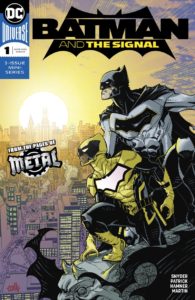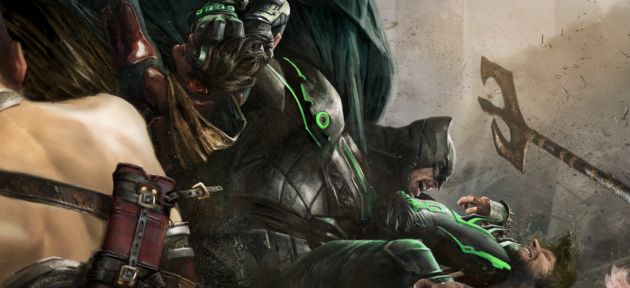 Batman and the Signal #1
Batman and the Signal #1
Publisher: DC
Story: Scott Snyder and Tony Patrick
Pencils: Cully Hamner
Inks: Cully Hamner
Colors: Laura Martin
Letters: Deron Bennett
Batman and the Signal is a short three-issue mini-series that proclaims on the cover “From the Pages of Metal,” but long-time readers will know this story stretches farther back to We Are Robin, Robin War, and the Snyder run in the New 52 Batman. The core of the story is about Duke Thomas, a character introduced by Snyder way back in Batman (Vol. 2) #21, in 2013. Much has happened to the character since his introduction, and this mini-series takes him, and the Bat Family, into new directions, but ultimately its short issue run might be long enough to explore the character to his fullest potential.
The main cover is by issue artist Cully Hamner, and is striking immediately for its daytime depiction of Gotham City in general, and showing Batman out during the day (it appears to be sunrise). There is a warm yellow tone to the entire cover, which complements Duke Thomas’ (“the Signal”) costume, which is also yellow, and stands in stark contrast to the larger, darker, shadowy figure of Batman, who looms over both his new young protégé and Gotham City itself. It’s extremely rare to see Batman operating in Gotham during daylight, and the choice to do so on the cover immediately announces to the reader that this is a different kind of Bat-book.
Hamner’s art in the interior of the book is excellent, particularly his figures and facial expressions. For Jim Gordon, for example, Hamner makes the choice to show Gordon’s face a bit older, with some deep lines from a combination of age, worry, and job stress. Throughout the years other artists have sometimes shown Gordon looking a bit younger with fewer distinguishing characters, but Hamner chooses to depict Gordon as a weary, but determined, Commissioner, making him appear more human and relatable. For interior scenes, most panels show nice background details, which are often over-looked or greatly simplified by some artists. The action scenes are fluid and dynamic.
The art is accompanied by Laura Martin’s excellent colors. Most recently, I’ve seen her work on Wonder Woman. Here, she’s called upon to use some unique color combinations as we constantly bounce back-and-forth between daytime and nighttime Gotham, and her choices of colors help define these two very different sides of Gotham. Throughout, Duke’s yellow Signal costume always manages to stand out, even in the more brightly colored morning scenes, which fits Duke’s description of a Signal being “the first knight out” in the morning light.
The script by Tony Patrick (based on a story he and Scott Snyder developed) jumps right into the post-events from Duke’s appearance in the Metal event, but also does call back to characters developed prior to DC Rebirth (such as Duke interacting with, and even dating one of, his fellow Robins from We Are Robin). There’s a lot to cover in this first issue, including providing background for those new to the character, understanding his place in the Bat family, calling up past appearances over the years as a way to appease long-time readers, and of course introduce a threat and overall conflict. It’s almost a bit too much for just one issue, and at the end of the issue, one can’t help wondering if the entire story is too long to fit into three tidy issues. It already appears rushed, and having only two more issues to sort everything out seems a bit aggressive. There are also some awkward timeline issues that are difficult to reconcile (Batman at one point mentions that Duke has trained with him longer than anyone else, yet other characters like Dick Grayson have already been operating independently for a while, and yet he presumably also trained with Batman for a while before becoming Robin and then Nightwing, but Duke didn’t show up until long after Dick left the cave), and there a lot of newer characters to keep track just in this one issue.
Overall, this series does hold a lot of promise. The art and coloring are excellent, and the idea of having a Bat operative who is active during the day in Gotham and who also has some meta-human powers, unlike every other member of the Bat family, is an intriguing one. As a single issue, Batman and the Signal suffers from trying to do too much, which on retrospect seems intentional based on the short length of the series. Opening it up to six, or even four, issues, may have helped with the pacing.
Martin Thomas
martin@comicattack.net



Pingback: Character Spotlight: Duke Thomas – ComicAttack.net